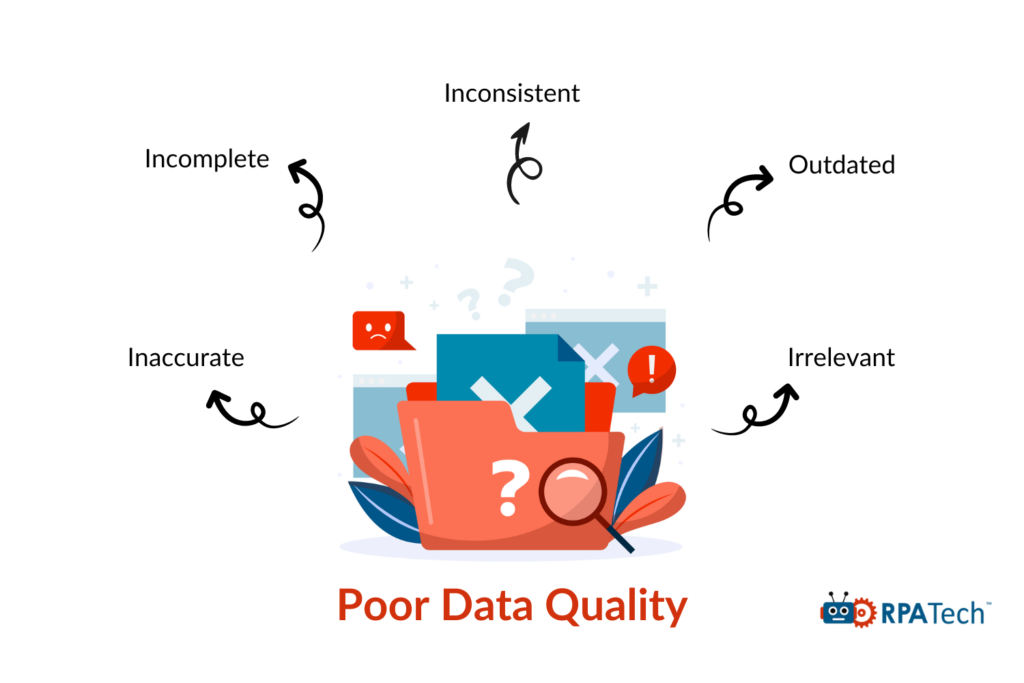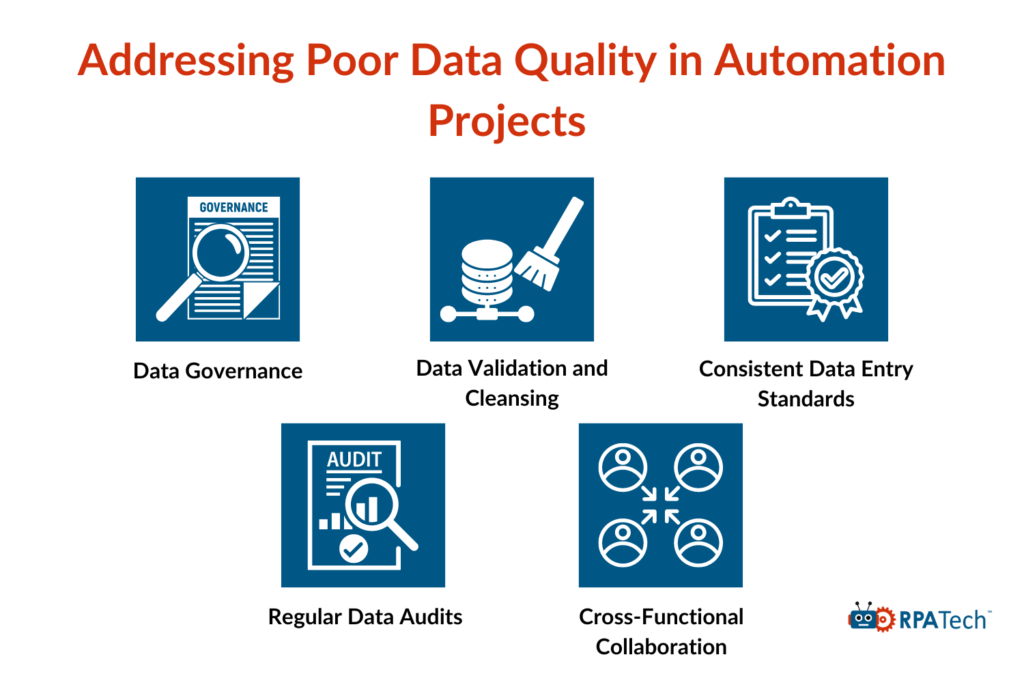Businesses are rapidly adopting automation to streamline their processes, reduce costs, and increase efficiency. However, the success of any automation project depends significantly on the quality of the data used to fuel it. But, if the data fueling the automation is of poor quality, it can lead to significant hurdles. Poor data quality is like a rusty engine that can significantly hinder the success of automation projects.
According to Gartner’s research, organizations lose an average of $15 million per year due to poor data quality.
This blog aims to help you understand:
- What is Data Quality?
- Defining Poor Data Quality
- Understanding the Difference: Poor Data vs Bad Data Quality
- How Poor Data Quality Impacts Automation Projects?
- Real-World Example of Poor Data Quality in Automation Projects
- Addressing Poor Data Quality in Automation Projects
What is Data Quality?
Data quality is about how good or bad a set of data is. High-quality data is right on the money, complete, consistent, up-to-date, relevant, and reliable. These features make sure that the data can be used properly for its planned use, like driving an automated process, making reports, or making business decisions.
Defining Poor Data Quality

Poor data quality occurs when one or more of the key attributes are compromised. Let’s break down some common characteristics of poor data quality:
- Inaccuracy: Data contains errors or inaccuracies that lead to false conclusions.
- Incompleteness: Important pieces of data are missing or incomplete, resulting in fragmented information.
- Inconsistency: Data that varies across sources or doesn’t align with other data sets.
- Untimeliness: Outdated data or data that is not available when needed.
- Irrelevance: Data that does not serve the intended purpose.
These issues often arise from human error, inadequate data governance, lack of standardized processes, or poor integration of disparate data sources.
Although it may not be visibly flawed, poor data quality can significantly impact the outcomes of an automation project.
Understanding the Difference: Poor Data vs Bad Data Quality
The terms “poor data quality” and “bad data quality” are often used interchangeably, but they can imply subtle differences depending on context and interpretation. Here’s a breakdown of their potential meanings and how they might differ:
- Poor Data Quality:
- Implies a lack of adequacy in one or more dimensions of data quality. This can include issues like inaccuracies, incompleteness, inconsistency, outdated data, or data that is not relevant to the context.
- It may suggest that the data is not as reliable or useful as it should be but does not necessarily imply that it’s unusable. Poor data quality can sometimes be improved through data cleaning, validation, or other corrective measures.
- It’s often used in discussions around data quality management and the need for continuous improvement to maintain data integrity.
- Bad Data Quality:
- Typically implies a more severe level of data issues. Bad data quality can refer to data that is significantly flawed, erroneous, or misleading to the point that it could cause harm, lead to wrong decisions, or compromise systems.
- The term can suggest a broader, more critical problem, indicating that the data may be beyond simple repair or that it requires significant intervention to be useful.
- It can also refer to data that has been deliberately tampered with, contains serious errors, or is corrupted, which might require extensive data correction or even replacement.
Overall, the difference between poor and bad data quality might be one of degree and severity. Poor data quality typically indicates that there’s room for improvement but isn’t necessarily a complete disaster, while bad data quality implies a critical level of error or corruption requiring significant attention and remediation. Nonetheless, the terms can overlap, and their usage might vary based on context and industry norms.
How Poor Data Quality Impacts Automation Projects?
Automation projects are heavily reliant on high-quality data to operate effectively. Poor data quality can significantly impact automation in various ways:
- Inefficiencies: Imagine trying to follow a recipe with missing or incorrect measurements – you wouldn’t end up with the dish you intended. Similarly, if data is wrong or inconsistent, automated systems won’t work properly, causing delays and inefficiencies.
- Increased Costs: If you’re using a faulty map for a road trip, you’ll waste time and fuel taking wrong turns. Similarly, poor data quality requires extra resources to fix mistakes or redo processes, raising operational costs.
- Decision-Making Challenges: Using faulty data is like trying to predict the weather with a broken thermometer – you’ll probably make wrong decisions. In the same way, poor data quality can lead to incorrect conclusions, affecting decision-making in automation projects.
- Loss of Trust: If a news outlet consistently reports inaccurate information, people will stop trusting it. Similarly, when stakeholders see errors in automated outputs, their confidence in the system decreases.
- Compliance Risks: Poor data quality can be like neglecting to read the small print in a contract – it can result in violations of rules and regulations, posing legal and financial risks to businesses.
- Incorrect Outcomes and Decisions: If an automatic email system has wrong customer information, it might send out incorrect recommendations or process transactions wrongly, like a mail carrier delivering letters to the wrong addresses.
- Incomplete Automation Processes: If a robot is missing a piece, it won’t be able to complete its tasks. Similarly, missing or incomplete data can stop automated processes from fully performing their tasks.
- Risk of Erroneous Insights: If a doctor bases their diagnosis on inaccurate test results, they might give incorrect advice. Similarly, poor data quality can lead to misleading insights from analytics or machine learning models, leading decision-makers to make poor decisions.
Real-World Example of Poor Data Quality in Automation Projects
To illustrate the impact of poor data quality, let’s consider the following example:
A manufacturing company decided to streamline the process of managing inventory and improve efficiency by automating its inventory management system. However, inconsistent data from multiple sources fed into this automated system, causing a significant problem. This discrepancy in the data caused the system to regularly generate incorrect inventory levels.
This miscalculation of inventory levels disturbed the smooth running of the company’s operations. The company had to face unforeseen production delays as the necessary parts were not always available when they needed them. This necessitated additional manual checks, which led to spending more time on inventory management rather than actual production.
Moreover, the incorrect inventory levels also raised the company’s costs. The company found itself either ordering more parts than necessary or not ordering enough and then having to expedite orders at a higher cost.
To resolve the issue, the company had to invest significant resources in data validation and cleansing. This unexpected expense further raised the operation costs.
Poor data quality profoundly impacts automation projects. It’s akin to constructing a house on an unstable foundation. Regardless of the design’s beauty, the structure is likely to collapse eventually. Inaccurate data results in inaccurate outcomes, leading to inefficiencies, rising costs, and ultimately, poor decision-making.
However, there are methods to transform poor data quality into good data. We’ll explore these in the following section.
Addressing Poor Data Quality in Automation Projects

To avoid the negative impact of poor data quality, it’s essential to take proactive steps to ensure data integrity in automation projects. Here are some key strategies:
- Data Governance: Establish clear policies and processes for managing data quality. Assign responsibilities and ensure everyone understands their role in maintaining data integrity.
- Data Validation and Cleansing: Implement tools and processes to validate and cleanse data before it’s used in automation projects. This step is critical for preventing errors.
- Consistent Data Entry Standards: Standardize data entry processes to reduce human error. Provide training and clear guidelines for data entry personnel.
- Regular Data Audits: Conduct periodic audits to identify and address data quality issues. This proactive approach helps maintain high data quality over time.
- Cross-Functional Collaboration: Ensure effective communication and collaboration among teams involved in data processing and automation. This fosters alignment and reduces inconsistencies.
Conclusion
Poor data quality can have far-reaching effects on automation projects, impacting efficiency, costs, decision-making, and trust. By understanding the characteristics of poor data quality and implementing strategies to address them, you can ensure the success of your automation projects. Prioritizing data quality is not just good practice; it’s essential for achieving optimal outcomes in your automation projects.
How RPATech Can Help?
We’re a company specializing in Intelligent Automation, utilizing AI to improve your business operations. See our Services & Solutions section for our full range of offerings.
Alternatively, you can book a consultation with our experts who will assist in identifying the best solutions for your business challenges.
We also offer a half-day discovery workshop. Here, we identify ideal processes for automation within your business, assess the feasibility and complexity of automation, and guide you on starting your automation journey.




